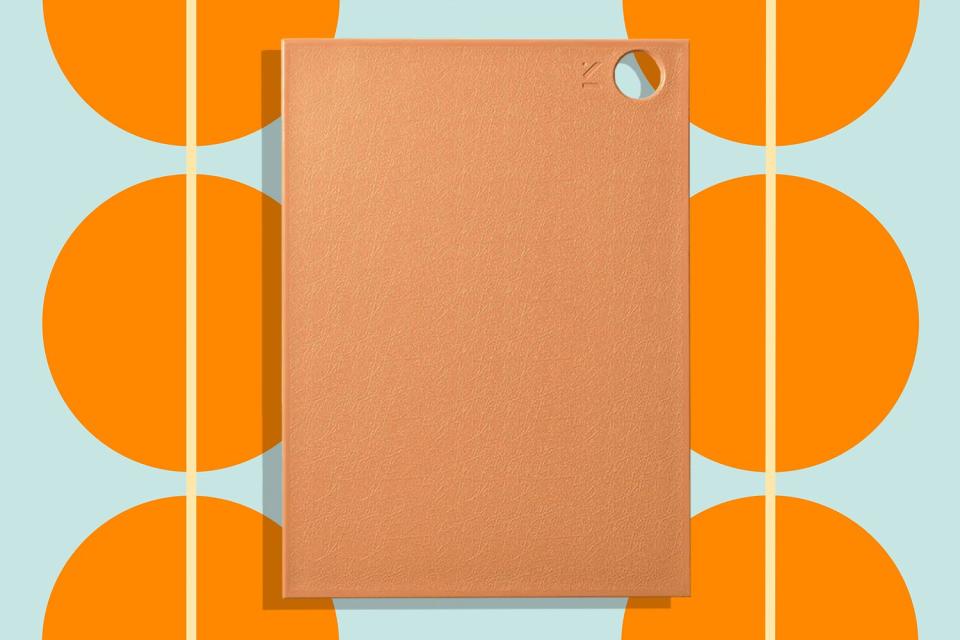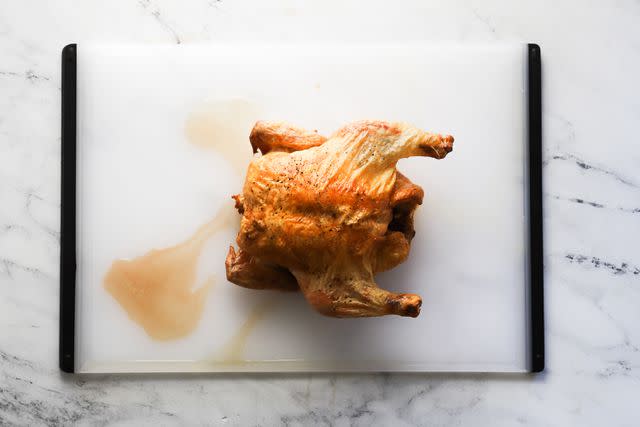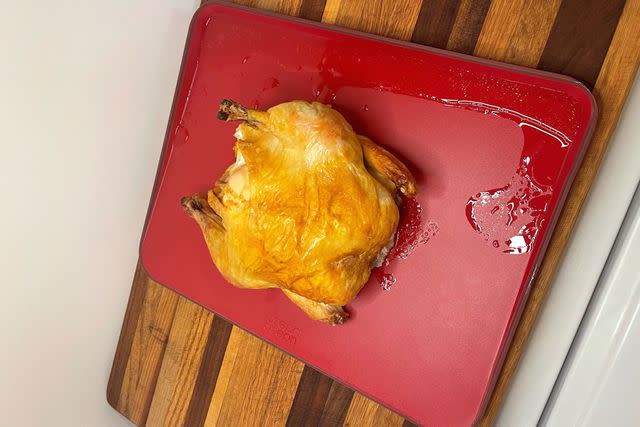The 5 Best Plastic Cutting Boards, Tested and Reviewed
Dotdash Meredith and Yahoo Inc. may earn commission or revenue on some items through the links below.
Our top picks are durable, non-slip, and easy to clean.

Material
Cutting boards are one of the most ubiquitous cookware items — you’ll find them in nearly every kitchen. In fact, it isn’t easy to even cook at all without them. They come in many different materials, each with pros and cons, though unfortunately, many are made with only aesthetics in mind. And while we love a decorative cutting board to display on the counter, the best cutting boards favor function over form when it comes to practical cooking.
In this sense, plastic cutting boards frequently rise above the rest. They’re usually cheaper, more durable, and better for your knives than any other material. The great thing about plastic is that it can be molded into nearly any shape, size, or thickness — big enough to carve a whole turkey, thin enough to store, or thick enough for durability. While testing cutting boards, a few plastic ones stood out.
Best Overall: OXO Good Grips Carving and Cutting Board

Pros
We loved this board’s non-slip grips and juice reservoir.
Cons
Serrated knives leave marks on this board.
We loved this board for so many reasons; it’s difficult to name just a few positive attributes. What stood out the most was the non-slip nubs on each side that keep the board from sliding around dangerously. They also came in handy when we broke down slippery whole chickens. The cutting board also includes a deep juice reservoir, which keeps your countertops clean and sanitary. In our tests, we noted that when using a serrated knife to cut bread, some marks were left on the surface of the board due to the knife's serrations. That said, this is an all-around favorite for its clever and functional design.
Price at time of publish: $33
Materials: Plastic
Dimensions: 14.34 x 21.11 inches
Care instructions: Dishwasher-safe

Food & Wine / Taylor Murray
Best Value: Choice Polyethylene Cutting Board

Pros
These boards are super durable and easy to clean.
Cons
The large size of this board can be undesirable for some.
Most professional kitchens buy these plastic cutting boards by the tens; you’ll find them in nearly every restaurant prep area. They’re cheap and durable, and they can take the daily wear and tear of restaurant kitchens. And when they’ve been beaten up beyond use, they’re affordable to replace. These boards are workhorses, no-nonsense and straightforward — plus, they’re antimicrobial and easy to clean. The large size makes them great for big jobs, but some may find them more cumbersome than the usual-sized boards.
Price at time of publish: $7
Materials: High-density polyethylene
Dimensions: 18 x 12 x 0.5 inches
Color Options: White, green, red, yellow, yellow, blue, and purple
Care instructions: Dishwasher-safe
Best Splurge: Hayate Yoshihiro Hi-soft High Performance Professional Grade Cutting Board

Pros
This board is best for long-term knife care and comfort.
Cons
The thick material makes this board hard to maneuver and store, and it’s pricey for a cutting board.
This high-end board is the one you’ll find many professional chefs reaching for to protect their knives. Its soft, rubber texture is perfect for maintaining your knife’s blade. Nathan Winkler-Rhoades, chef and co-owner of Pitruco Pizza In Philadelphia, Pennsylvania, always has a Yoshihiro Hi-soft High Performance board in his kitchen. He loves this board because “it’s good for really sharp blades and is just less stress on your hand.” The thick material is great for cooking but is cumbersome; this board can be difficult to store and lug around. Still, for kitchens with the space, we recommend this board has a spot in your cupboards.
Price at time of publish: $130
Materials: Polyvinyl acetate
Dimensions: 15.8 x 8.8 x 0.8 inches
Care instructions: Hand wash recommended
Related: The 5 Best Vegetable Choppers for Faster Food Prep
Best Looking: Material The reBoard

Pros
This beautiful board is easy to store and is made from recycled material.
Cons
There’s less usable area on this board due to the size and hole in the corner.
Available in six rich colors, this stunning board is an excellent choice for the sustainably-minded; it’s made with 75% recycled plastic from kitchen scraps and 25% renewable sugarcane. This reinforces the plastic, giving you a more durable board with a longer life before a replacement is needed. The extra durable material means there’s less of it, so this board is very slim and easily slides into almost any space in your kitchen. Plus, there’s a handy hole in the corner, making it perfect for hanging. However, the downside of the hole is that it reduces the workable area of this already smaller-than-average board. That said, we wouldn't mind pulling this board out at a dinner party to slice some lemons or limes or chop a quick onion for an easy weeknight meal.
Price at time of publish: $35
Materials: Recycled plastic and sugarcane
Dimensions: 14.75 x 10.75 inches
Color Options: Sand, Coral, Tide, Deep, To Pó-Po, with Love, and Reimagine Justice
Care instructions: Dishwasher-safe
Related: We Tested the Best Chef's Knife for Every Type of Task
Best for Carving: Joseph Joseph Cut and Carve Plus

Pros
This board is perfect for carving due to its unique slope and grabby spikes.
Cons
It isn’t large enough to accommodate many foods beyond chicken.
The best feature of this board that makes it perfect for carving is the patch of spikes in the middle. We were initially skeptical of their effectiveness, but the second we started breaking down a chicken on the board, we noticed how amazing these grippy spikes worked at steadying the chicken. We also loved the angled surface of the board, allowing all the juices to run to one end, eliminating the need for a reservoir that usually runs around the board's perimeter. While this board is great for breaking down a whole chicken, it’s just not made to accommodate things like a baguette or larger meats like a whole turkey.
Price at time of publish: $18
Materials: Polypropylene
Dimensions: 14.76 x 11.61 x 0.98 inches
Color Options: Sky and Green
Care instructions: Dishwasher-safe

Food & Win / John Somerall
Related: The Best Charcuterie Boards for Perfect Grazing
Our Favorite
The OXO Good Grips Carving Board and Cutting Board snagged our top spot due to its versatility, durability, and extra features that made it stand out from the rest. The Yoshihiro Hi-soft High Performance Professional Grade Cutting Board is the best board to protect your knives and ease the stress on your joints.
Factors to Consider
Material
All plastic is not created equal. Surprisingly, plastic cutting boards can be made of many different types of plastic with different properties. The most important thing to look for is BPA-free plastic. When it comes to materials that touch your food, it’s always better to be safe and avoid anything that could leech harmful substances like BPA into your food. Many cutting boards are made of high-density polyethylene, which is incredibly durable and doesn’t take on stains or unsightly smells from different foods. Polypropylene is very similar to polyethylene and is also an affordable and common material. Polyvinyl acetate, a type of vinyl resin, is also sometimes used due to its “rubbery” texture, which is the best material for knife blades.
Size and Thickness
What size cutting board to buy depends on what you usually use it for. If you’re a casual cook or someone who usually only cooks for one or two, a smaller size is best, especially if you have limited space in your kitchen. However, for those who are often found breaking down a whole chicken or chopping enough fresh veggies for a family of five, a board with a larger surface area is a better match. When it comes to thickness, a thicker board is more durable, but the tradeoff is that they’re generally more cumbersome and harder to store.
Durability
Plastic cutting boards are more durable than glass and can be more durable than wood, though not indestructible. Juan Ocampo, the executive chef at Village Vine in Swarthmore, Pennsylvania, says it’s time to get a new one when “thick grooves begin to show.” He also warns against staining but still favors plastic, saying plastic boards are “much easier to maintain than wood.” Plastic boards don’t usually bend and crack, but they can warp — particularly if they’ve been run through the hot dishwasher too often. Ultimately, you’ll get much more life out of a plastic cutting board than any other material.
Care
The great thing about plastic is that it doesn't require seasoning or conditioning, unlike wood. Even so, some boards require a bit more upkeep than others. Many can’t go in the dishwasher and need a good hand scrub to stay clean. Super high heat, like that of the sanitizing cycle of the dishwasher, can warp or bend the board's plastic, so hand washing can be best for many models, especially thinner ones.
Our Plastic Cutting Board Tests
In order to find the best plastic cutting boards, we evaluated a number of factors. We first observed the material and dimensions of the board. We also looked to see if the board utilized any special design features, like a drip edge to catch juices or carving spikes.
We then carved a baguette with a serrated knife and looked for marks or scratches on the board's surface. Then, using a large chef’s knife or slicer, we carved a whole chicken into eight pieces. We analyzed how much space on the board the chicken took up and if it was fit to handle a turkey. We also assessed whether its juice well (if it had one) was large or deep enough to collect the juices from the carved chicken adequately or if it had any design features that made carving the chicken easier or more difficult.
Finally, we thoroughly cleaned each carving board according to the manufacturer’s instructions, recording how easy or difficult it was, if the board was dishwasher-safe, and if the board seemed prone to chips, scratches, and or staining from ordinary use.
Frequently Asked Questions
How do you clean a plastic cutting board?
All plastic cutting boards can be hand washed with dish soap, warm water, and a sponge. Just like handwashing any other dish or kitchenware, some extra scrubbing may be necessary for foods that are dried or stuck on. Some boards are dishwasher-safe and can just be tossed in with your regular dishes. Always check the manufacturer’s recommendations on the best way to clean your board.
What are plastic cutting boards made of?
Plastic cutting boards are made of plastic, obviously, but not all plastics are the same. Most boards are made of safe, durable plastic meant to withstand knives' daily wear and tear. The primary types of plastic for cutting boards are polyethylene and polypropylene because they’re cheap, easy to manufacture, and have a long life.
Are plastic cutting boards more sanitary?
In contrast to wood cutting boards, plastic is much more sanitary. This is because the plastic used for cutting boards isn’t absorbent and doesn’t hold on to harmful bacteria. One thing to note, though, is that as you use cutting boards and your knife digs into the plastic, you have to clean it more thoroughly to ensure you get everything out of those groves to make sure it’s still being adequately cleaned.
Is it better to cut meat on a plastic or wood cutting board?
Wood is an absorbent material, meaning the juice — and subsequent bacteria from the meat — can hang around on the surface even after you wash it. Chicken, for example, can harbor Salmonella, E. Coli, and Campylobacter, just to name a few. All of which can spell significant trouble for you and your digestive system. Cutting meat on plastic tends to be safer because it can be much easier to clean and sanitize.
Our Expertise
Nick DeSimone wrote and compiled this list. During their nearly decade-long career working in professional kitchens, Nick has used almost every cutting board. Plastic has been the material of choice at all the restaurants they’ve worked at. Because of this, Nick has spent years trying different types and field-testing their favorites.
Nick also spoke to fellow chefs Nathan Winkler of Pitruco Pizza and Juan Ocampo of Village Vine. Chef Winkler is a pizzaiolo who spends his days chopping pizza toppings and slicing hot pizzas fresh from the oven. He knows what materials are durable for sharp knives and hot pizza. Chef Ocampo, who runs Village Vine, is a jack of all trades and can be found finely mincing garlic, carving roasted meat, or batch-preparing pounds of veggies. Chef Ocampo uses cutting boards for nearly every purpose, so he always reaches for durable plastic for longevity.
For more Food & Wine news, make sure to sign up for our newsletter!
Read the original article on Food & Wine.

